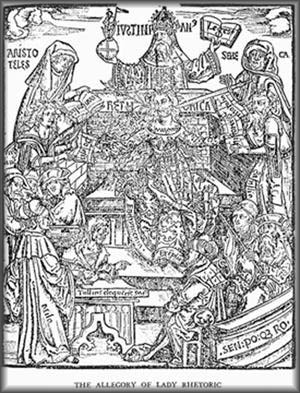Allegory of Lady Rhetoric


Clark, Donald Lemen (1957). Rhetoric in Greco-Roman Education (NY: Columbia UP).
The narrative with this frontispiece reads as follows:
"The allegory of Lady Rhetoric owes its popularity in postclassical times and later to Martianus Capella, whose Marriage of Philosophy and Mercury combines a compend of the Seven Liberal Arts with allegorical descriptions of these Seven Learned Ladies. Lady Rhetoric, as presented in the woodcut from the medieval encyclopaedia Margarita philosophica (1504) reflects a remarkably accurate and full statement of Greco-Roman rhetoric. By the sword and the lily which extend from her mouth she represents allegorically the two traditional functions of rhetoric: to attack and defend by verbal arguments and to embellish speech with verbal adornment. The beauty of her gown and the charm of her coiffure represent beauty of style as first taught by Gorgias. The words embroidered on the hem of her robe remind us of the colores, or figures of speech, and the enthymemes and exempla, types of deductive and inductive argument.
Aristotle at the top of the picture represents rhetorical and natural philosophy; Justinian, the use of
rhetoric in support of law; Seneca, moral philosophy and the educational system of the Roman
schools of rhetoric; and Sallust, history. Rhetoric is embraced by the Zone of Justice. The
presence of Virgil with laurel crown emphasizes rhetorical influence on the style of poetry. In the
foreground Cicero is clearly shown defending Milo in a court of law, and the Senatus Populusque
Romanus figures forth the scene of deliberative rhetoric."
